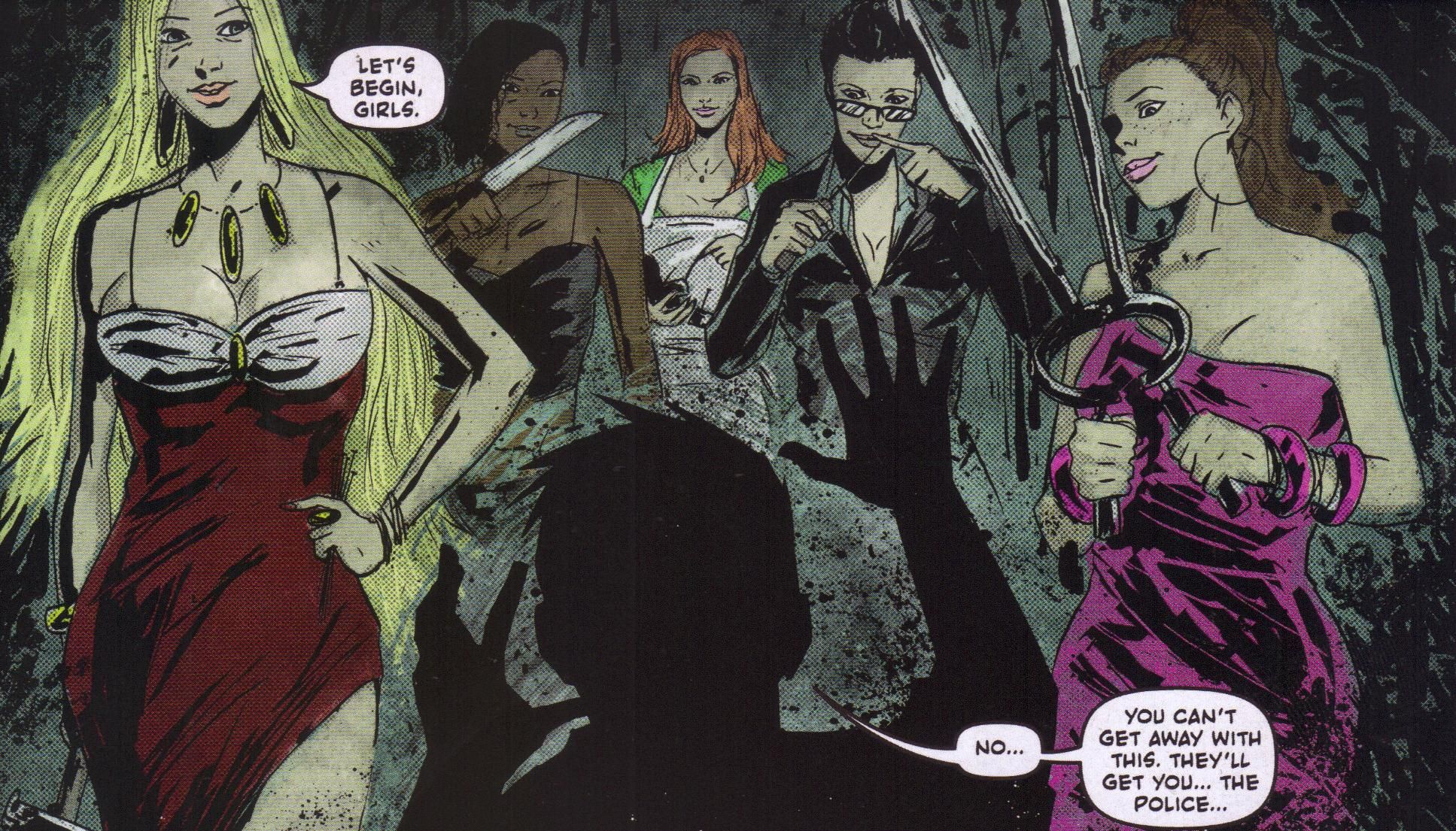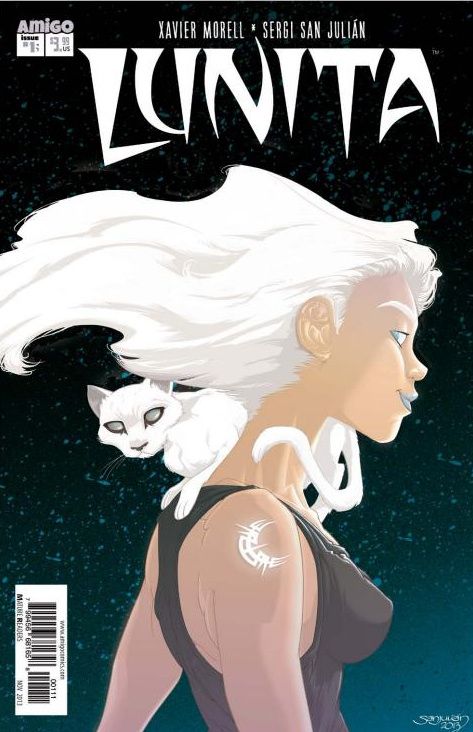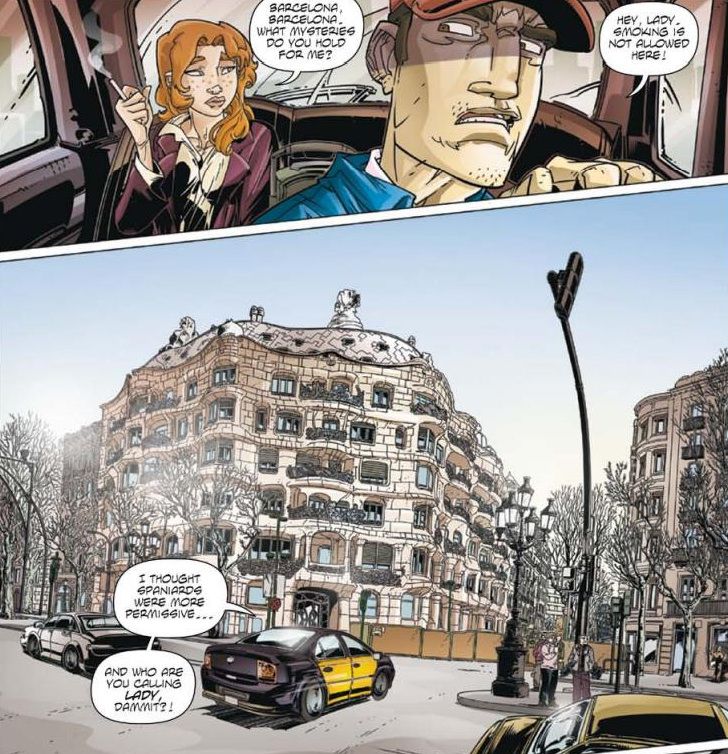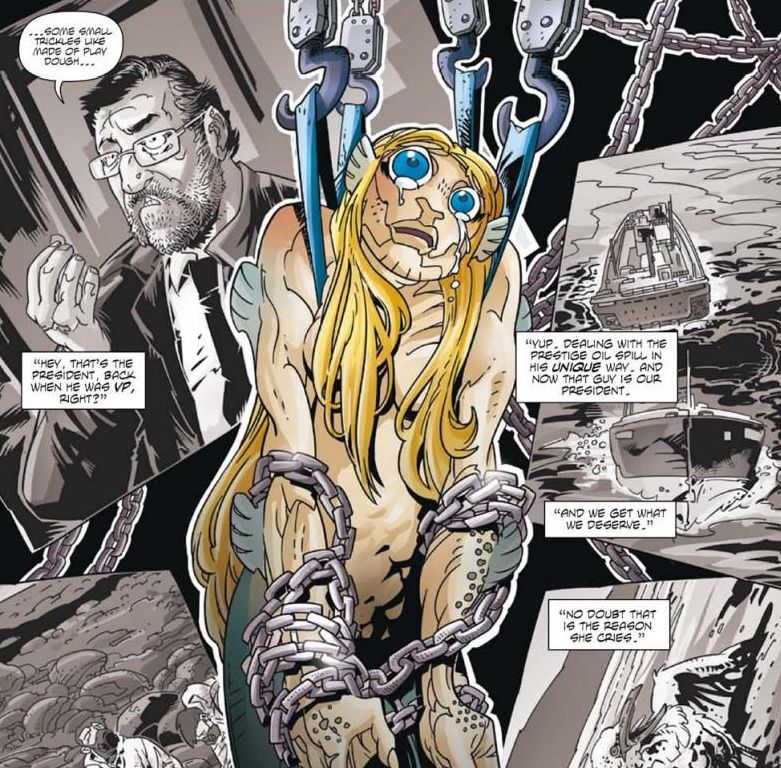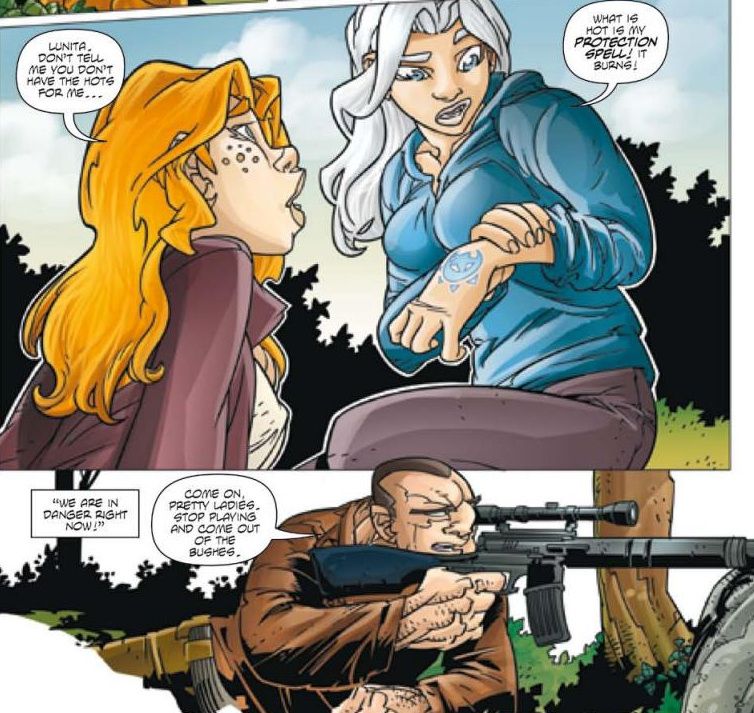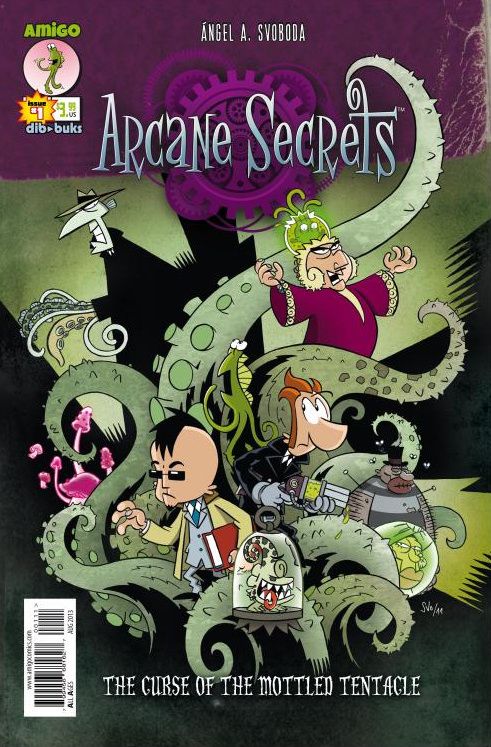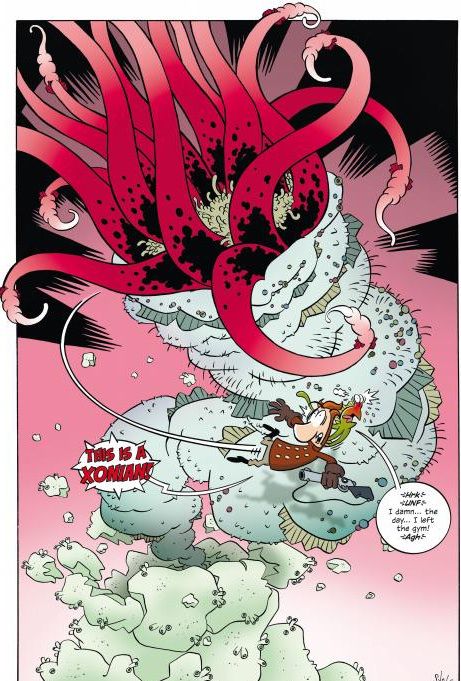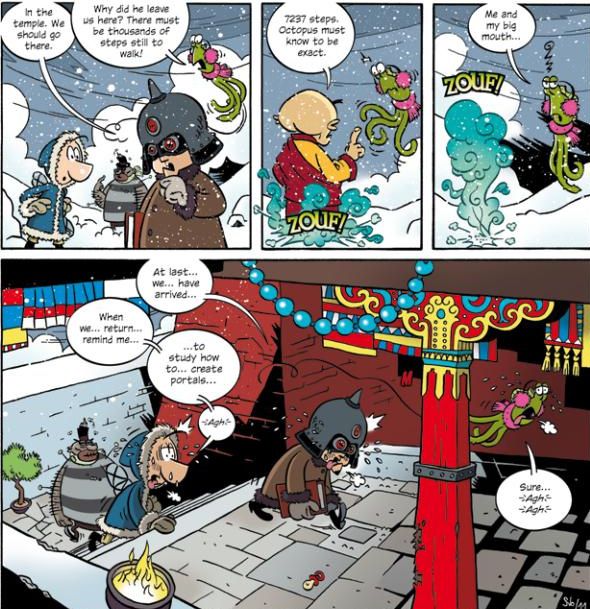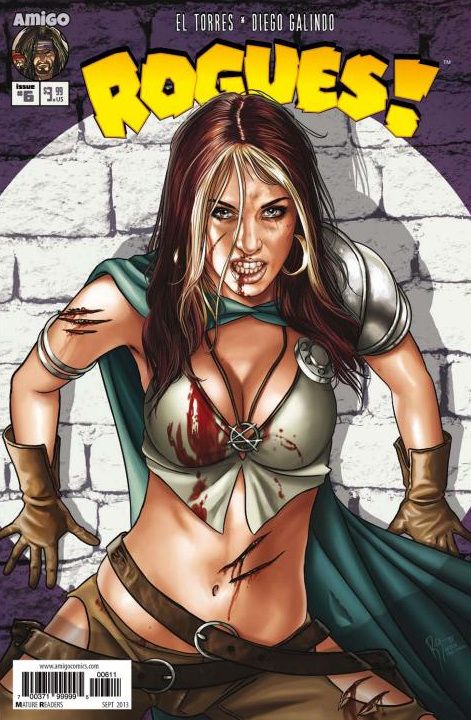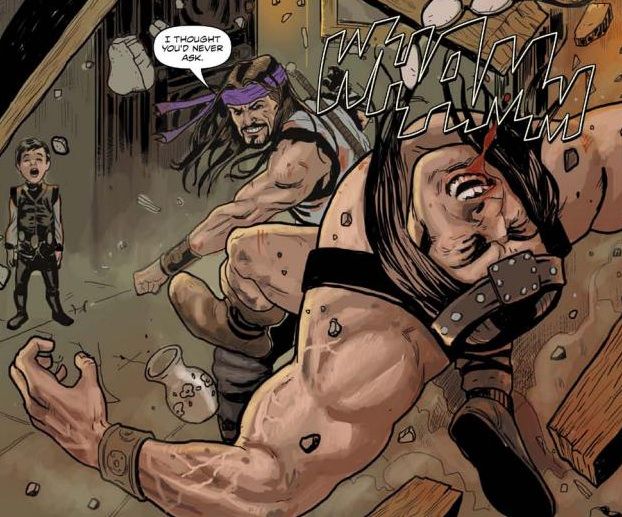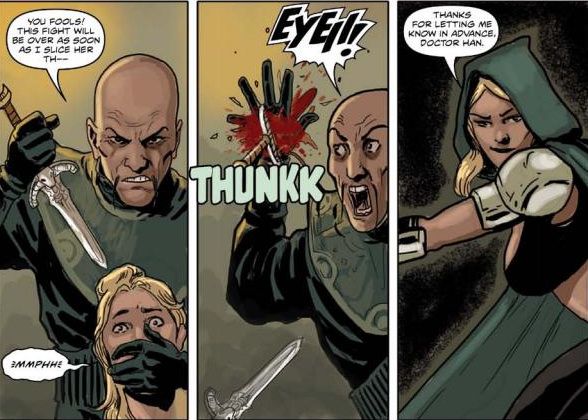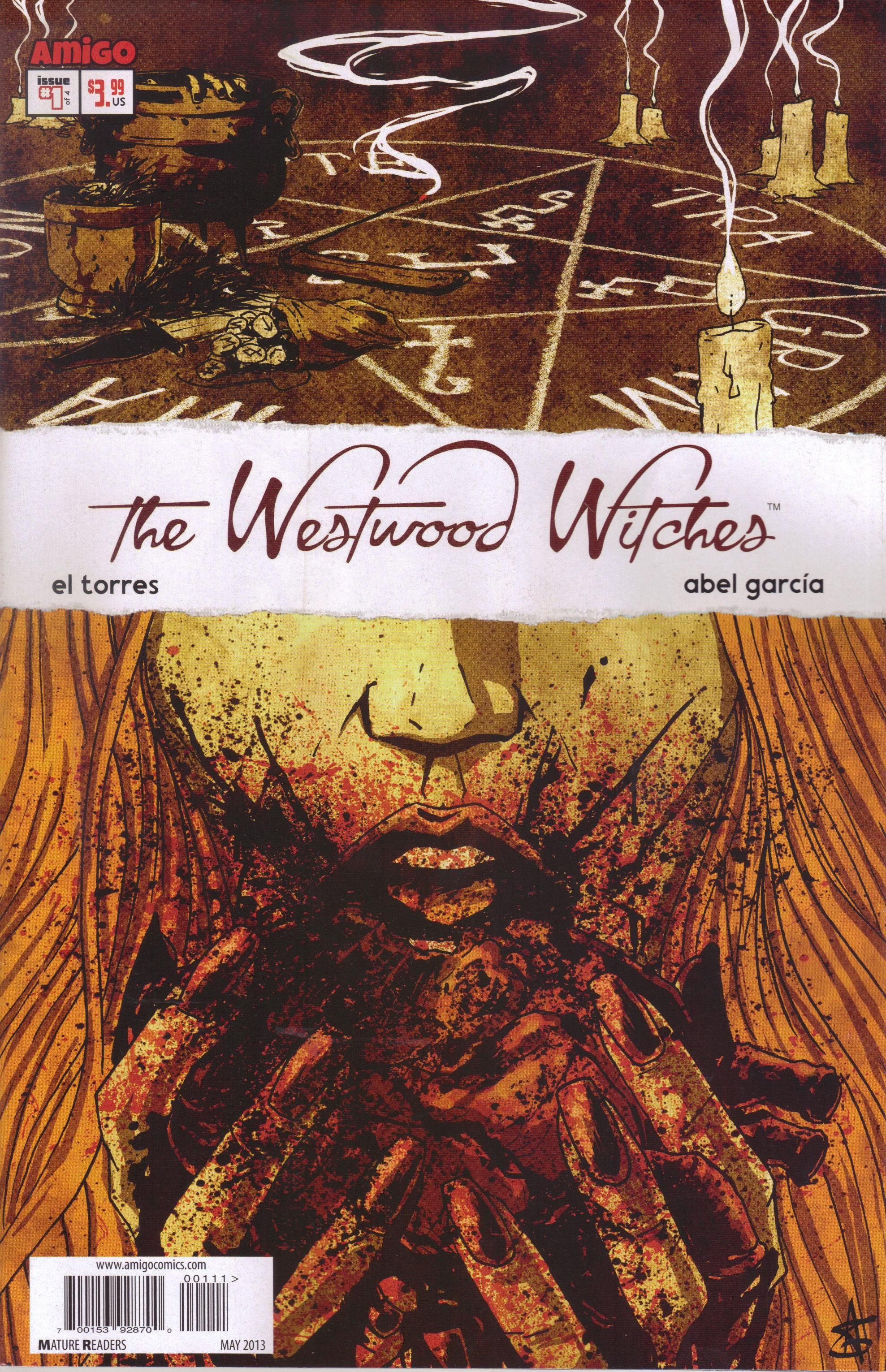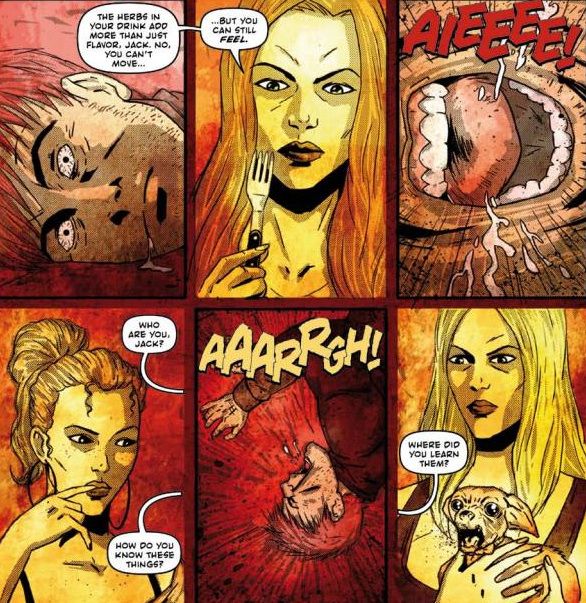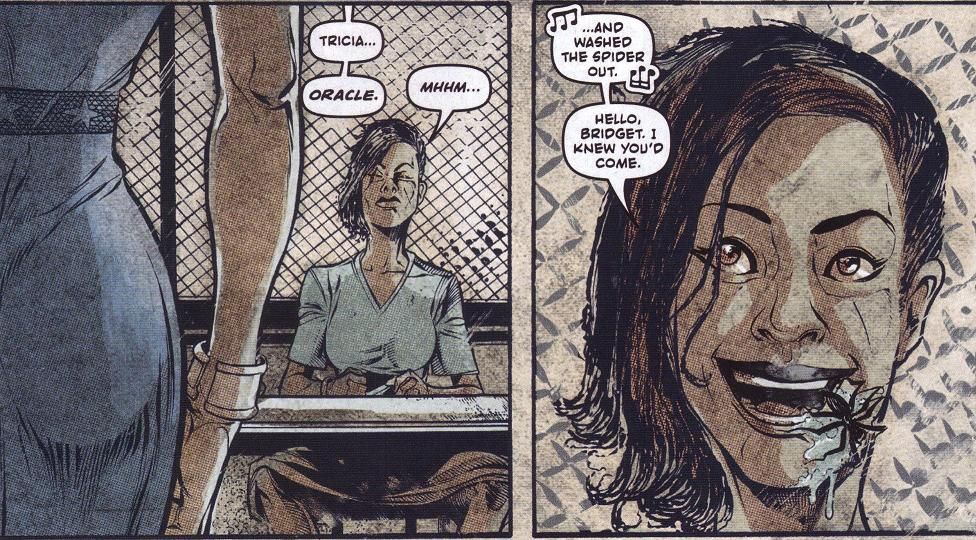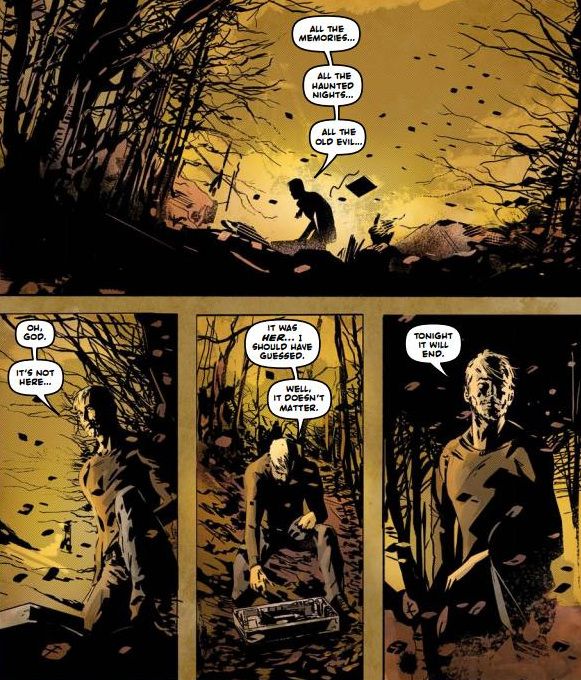Let's throw them in the blender and see what comes out!
A few weeks ago, I mentioned that it's disappointing that Amigo Comics have slipped in their scheduling, because they publish some cool comics. El Torres, who founded the company and writes a few of their comics, is a Facebook friend, and he was kind enough to send me a bunch of .pdf files so I could review some of the company's offerings, in case you missed them. I'm glad he did; I didn't pre-order all of Amigo's comics, because it's hard to figure out which ones are going to be good. I know El Torres's work, so I was happy ordering his stuff, but I wasn't familiar with the other creators, which makes it more of a crapshoot. But let's check out some of the comics he sent my way!
First up is Lunita #1, which is written by Xavier Morell, drawn by Sergi San Julián, colored by Oriol San Julián, and lettered by Malaka Studio. This is the first issue in a four-issue mini-series and costs $3.99.
Morell created the character of Lunita a decade ago, but her adventures never made it to the States because the comics companies set to publish them kept going out of business (including Narwain Publishing, which I still miss). So he decided to keep the character but move her along in her life - in the original comic, she was on a team, but it's been disbanded in this series (Morell gives us a brief update on what's happening with the others, which is nice). Lunita herself is apparently a witch, but beyond that, Morell doesn't get into her powers too much. She was on a team that investigated paranormal phenomena in Spain, so obviously she has some connection to the supernatural.
Lunita comes into the story in a roundabout way, which is kind of neat. The story begins in California, where the American ambassador to Spain has died of an odd overdose. One of the policemen investigating the death is involved in the trade of a new Spanish drug, and he's not happy because it's too strong. Then we switch to Barcelona, where the DEA has sent Summer Fillion (is Morell a fan of Firefly?) to find out what's going on with the drug. Fillion is being followed, apparently by an agent of the Spanish government, and his job is to find a good time to kill her. Meanwhile, his boss is the one creating the drug, which is made from mermaid's tears. Yes, it really is. They have a captive mermaid and they force her to watch footage of environmental damage to the ocean, which makes her cry. It's rather clever, actually.
Meanwhile, Fillion meets with Lunita (she seems to know her, so maybe Fillion is a returning character as well), but before they can start on the case, the man following Fillion prepares to kill her. Thus endeth the issue!
Morell does a good job setting everything up in this issue. The case is weird and somewhat creepy - a drug made from mermaid's tears? - and it falls under the supernatural purview of Lunita and her team (even though she doesn't have a team). Morell introduces one of her team and takes him off the table cleverly, but because he actually bothered to spend time with him, I have to imagine he'll be back. The plot is quite neat and promises some strange stuff. Lunita is a typical activist, which is why her team was disbanded in the first place, but she's still an intriguing character. I'm less impressed with Fillion, who isn't as well defined. She's angry for no reason, and she assumes every woman wants to sleep with her. I suppose Morell is making her a stereotypical "male" character who puts the moves on every woman he sees, and by making Fillion a lesbian, he hopes to subvert that trope, but it's obnoxious behavior when a man does it and it's not any better when a woman does it. Fillion is an unpleasant character, so I hope she becomes more interesting as the book goes along. I don't really care if she's likable, but she should be less of a stereotypically obnoxious American (she won't eat Spanish pastries? really?)
San Julián does a nice job with the artwork - he has a good, cartoony style that allows him to show a lot of expressiveness on his characters' faces, but enough skill to render many parts of Barcelona very well, so that we get a good sense of place.
I always enjoy reading comics that take place in a certain location, and it's always nice to see artists able to bring those locations to life. San Julián also is good at body language, which makes Fillion's sexual aggression a bit less creepy because he's able to show that's it more flirtatious, even though it's still not the best behavior. San Julián draws a great mermaid, too - she looks vaguely like mermaids of legend, but he makes her much more piscine, so she's not drop-dead gorgeous, because she looks like a sea creature. San Julián gives the book a bit of an eerie edge, so even though it's brightly colored and well lit, we still get a good sense of strange things happening just beneath the surface of reality.
This is a nice start to the series, and it's neat to see the way a Spanish creative team does a book like this, because there are some similarities and some nice differences between this and, say, an American comic on the same topic. I hope there's a trade paperback, because now I'm interested in getting it.
Rating: ★ ★ ★ ★ ★ ★ ★ ☆ ☆ ☆
Up next is Arcane Secrets #1-2, the first two issues of a three-issue mini-series. This is by Ángel A. Svoboda, and it's translated by Rafael Nieves and lettered by Malaka Studio. They both cost $3.99. This was initially published, it appears, in 2008, and now it has arrived in the States. It's an "all-ages" comic about a Cthulhu cult, although they call their god "Xulu." It's for the kids!
The villain of the book is a mobster called Sal Tamontti, who runs the Order of the Tentacle.
For some reason, he wants to acquire a piece of a tentacle, and he lures his nemesis, Doctor Balthazar Ment, into an odd scheme that allows him to get that piece. The tentacle curses people by infecting them with flora, which allows Sal to control them mentally. So obviously Sal is going to try to do something with that. Meanwhile, Dr. Ment gets infected, and he, his assistant Harry, and a strange creature from another dimension go visit a witch in the swamps to get the cure. So they're out there, and Sal is doing something with the tentacle, and that's where we are at the end of issue #2.
I wasn't as impressed with this book as I have been with other Amigo comics, unfortunately. I wonder if it has something to do with the translation, because many of the jokes in these comics fall a bit flat. It's a charming book, but it feels like Svoboda wants this to be more like a Sergio Aragonés comic but he's not as funny as Aragonés is. Svoboda doesn't waste time with in-depth characterization, so the humor has to hit home, and it just doesn't too often. The plot is silly, but it's supposed to be silly, and Svoboda zips through things nicely. He uses the tropes of this kind of genre, from the creepy witch in the swamps to the Tibetan monastery, but it's just not that original and Svoboda's humor isn't funny enough to overcome the clichés that he uses. He has to use clichés, of course, but because he does, the humor has to overcome that, and it doesn't. I get that it's supposed to be all-ages, so Svoboda is aiming to a younger audience as well, but I wonder if younger readers won't have any idea about the Lovecraftian element to it, which weakens the humor. It's not funny enough for people who don't know about Lovecraft, and it's not clever enough for people who do.
It's relatively charming, but that's about it.
Svoboda does a pretty good job with the artwork, I will say. He blends the actual creepy stuff - it's not too creepy, but it's still tentacley - nicely with the goofiness, which is evident with Fisher, Sal's right hand man, who has a mass of tentacles as a right arm, which is kind of eerie. He does good work with the Unknown Zone, where Harry finds Elvis the helioglobus, who helps the good guys out. His visual jokes are a bit better than his verbal humor - when Dr. Ment is infected, Svoboda gives him a nice green Afro, which is funny. He also takes his time to make sure that the places where the action occurs is very detailed, from Selma's place deep in the swamp to the monastery in the Himalayas. It's a beautifully colored book, too. Svoboda is a better visual storyteller in these two issues than he is writer, and the art is the best part of the series.
I'd like to like Arcane Secrets more, but that's just the way it is, I guess. It's not a terrible comic, but it's not very memorable. Humor is so subjective that if it falls flat, the book gets dragged down, and that's the case with this book. It's fine, but nothing special. Oh well.
Rating: ★ ★ ★ ★ ★ ★ ☆ ☆ ☆ ☆
Up next is the final issue of this iteration of Rogues!, which I assume will be out at some point. El Torres himself wrote this, it's drawn by Diego Galindo, and lettered by Malaka Studio. It too is $3.99.
Torres finishes the latest story arc, as Bram and the Weasel, who had infiltrated the palace, found out that they were supposed to kill the magistrate's wife and children. Being honorable rogues, they decide that's not happening, so they have to fight it out with their companions. Obviously, they succeed, but the story doesn't end there.
Torres gives us a fun twist that both settles the question of their standing within the guild and sets up the next story line in the second volume of the title. Torres could have left the questions unanswered, but he's fairly clever about showing how the Weasel and Bram are rogue-ish but still willing to work within the law when it suits them.
The fun of the issue, like the previous one, is how Torres takes some familiar figures from the sword-and-sorcery genre and plays them for laughs. The others in the group fall into their stereotypes, and while they're not quite as formidable as they like to pretend, Torres still gets some good jokes out of them. The Conan analog who liked to rub oil all over himself gets the best lines, as he speaks in epic-sounding dialogue that earns him Bram's scorn. Meanwhile, there's another villain who likes to monologue about what he's about to do to his victims, which makes it easy for the Weasel to stop him and the female villain who gets upset when her secret identity is revealed even though no one knows who she is. Torres is clever enough to make these stereotypes work for him, because they are what we expect in a story like this, so the fact that Bram and the Weasel aren't like the stereotypes make them even more ridiculous. There's certainly a place for the "Conan" style of narration, which is partly why the recent Conan comics are so good, but there's still something to be said for taking that kind of writing down a peg. Torres is able to make the book exciting and violent while still having fun with it, which is nice.
Galindo continues to do a nice job with the artwork. His action scenes remain the weak point, but they are better than in issue #5, which means, to me, that he's getting better. He seems to do a better job with the layouts of the fight scenes in this issue, which is fairly important. As I noted last issue, however, this is a humor book as much as an action comic, and Galindo's facial expressions help the script quite nicely.
When Night Cat's mask comes off, Galindo does an excellent job showing her horror at realizing her "secret identity" has been blown. That's just one example, but Galindo's faces throughout make the script both more ridiculous (in a good way) but also more believable, as his characters react to things the way we'd expect them to react to such odd situations. He's done a fine job with both Bram and the Weasel, too - Bram's face is more open and trusting, while the Weasel knows that people suck, so she's much more cynical, and Galindo nails both of those expressions very well. I haven't seen the book in print yet, but I wonder if it will be darker, as I've wondered if digital coloring shows up darker on the page. The coloring on the book is solid, and nothing is too dark. I'm curious how it will look on the page.
If you haven't gotten Rogues! yet, I definitely would recommend the trade when it shows up. It's a fun, light-hearted action/adventure comic that feels somewhat familiar, but which works because Torres uses the familiarity to tell entertaining stories. Both his main characters are more interesting than you'd expect, and I'm looking forward to the next volume.
Rating: ★ ★ ★ ★ ★ ★ ★ ½ ☆ ☆
Finally, we have The Westwood Witches #1-4, which is the entire mini-series. Torres also wrote this, and it was drawn by Abel Garcia (issues #1-2), Roger Bonet (issue #3), and Ángel Hernández (issue #4).
Garcia colored the first two issues, while Eva Roman colored issue #3 and Esther Sanz colored issue #4, with Malaka Studio providing the lettering. Part of the delay on the book, I think, is because of the art changes, and it's too bad. All three artists have different styles, but they're similar enough that the art does have some continuity, and it's a shame that it wasn't drawn by the same artist, no matter who it was.
Anyway, the series is quite good, the best thing I've read from Amigo yet, which isn't a surprise as Torres is responsible for two of the better horror comics of the past few years. In The Westwood Witches, he introduces a writer, Jack Kurtzberg (yep), who has written a highly successful novel, Walpurgis Passion, that inexplicably became popular. So now he's trying to write a sequel, but he's having problems because, of course, he wants to be taken seriously as a novelist. He gets a call that his brother, Jim, is dead, and so he returns to his home town in Massachusetts, Westwood, for the funeral. He decides to stay because he thinks it will help his writing. What he doesn't know is that some of the his new neighbors are witches, and they are very interested in the new arrival. Jack is also trying to remember something about his childhood, something that he and his brother did in the woods, but he can't remember quite what it was.
The big twist at the beginning (there's more than one twist!) is that Jack's book is remarkably similar to the rites the witches themselves practice, which is why they're so interested in Jack.
They have called on the demon Baphomet, and one of them has been somehow taken away by the demon, and they realize that Jack somehow poses a threat to them. They attempt to destroy him, but that doesn't go as planned. Meanwhile, Jack becomes increasingly disillusioned with the sequel to his best-seller, even as his agent and his gold-digging wife get angrier at him. It all leads to a big showdown, of course, but I don't want to give too much away about it.
Torres has fun with the metafictional aspects of this comic, as he recognizes early on that the witches and their rites are fairly stereotypical. Baphomet, for instance, looks like the clichéd version of the demon that we've seen in popular fiction for a thousand years, but there's a reason for that. The witches themselves are clichés, too, but that's part of the fun of the book, as Torres uses those clichés to his advantage. Very often, lampshade hanging is simply done to show that the writer is aware of the stereotypes even if he or she does nothing with that. Torres, however, not only acknowledges the clichés, but uses them quite well in the book. As with his other horror stories, Torres is quite good at making things very creepy, which is always a good thing. However, he's also very interested in the juxtaposition between horror and innocence, as Jack is nostalgic for a time when his life seemed magical, meaning his carefree childhood with his brother.
Torres understands that the way he evokes innocence can make the horror more disturbing and even a bit sadder, as we realize that innocence lost is horrific even if it's not a horror book. Jack is a sad character who has to get past that sadness, and that really drives the story. Torres makes some other comments that revolve around this theme, from Jack "selling out" with his best-seller to getting grounded again when he's able to leave it behind, which Torres contrasts with Susan, his wife. On the witches' side, he manages to evoke some sympathy for them because they have something to protect and to lose. For all that, Torres still has some fun with the blending of "reality" and fiction, which makes the horror of the book a bit more interesting than your standard scary book.
Each artist does a pretty good job with the art, although, as I noted, it would have been nice to see one artist throughout. Still, all the artists have a good, scratchy line that makes the book look more sinister, although in issue #4, Hernández is a bit smoother than the other two, which is a bit unfortunate because the bloody parts don't look as awful as it does in the first three issues. What Hernández does well is the flashbacks to Jack's childhood, as his clear lines and Sanz's gorgeous yellows give us a good impression of the hazy innocence of childhood. He does draw a nice Baphomet, too. Garcia and Bonet have slightly different styles, but they both do a good job creating this dark world where creepy things lurk. Garcia's women, in particular, are impressive - they're tall, powerful, and big-breasted, and this depiction is actually a nice touch considering what we find out later. The other artists don't quite follow up on this, which is too bad. But that's a minor nitpick. The art, while not the strongest point for the book, is still pretty good, and it doesn't mess with the story, which is nice.
Of the Amigo comics so far, Rogues! is fun, but The Westwood Witches is a bit better, because Torres tries to do some deeper things with it while still playing around with the genre tropes. If you haven't picked up the issues yet, keep an eye out for the trade paperback!
Rating: ★ ★ ★ ★ ★ ★ ★ ½ ☆ ☆
I don't know how common Amigo's comics are around your comics shoppe, but I'm sure you can order them from their web site or from on-line retailers. They publish some pretty cool books, if you're at all interested!

